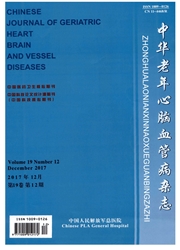

 中文摘要:
中文摘要:
目的探讨脑梗死后不同部位及不同外径脑小动脉硬化程度的差异。方弦通过回顾性观察38例脑梗死(脑梗死组)及15例对照病例(对照组)脑小动脉的病理变化。两组按小动脉管径大小叉分为〈50μm、50-100μm及〉100μm。采用完全随机分组设计对不同外径小动脉硬化指数进行定量分析。结景脑梗死组外径〈50μm的小动脉硬化指数为138.55±76.67,明显高于其他直径(P〈0.01),外径〉100μm间的小动脉硬化指数为78.07±32.06,与对照组无显著差异(P=0.174,F=38.795)。脑梗死组白质中〈50μm的小动脉硬化指数为152.86±87.83,明显高于灰质的127.97±64,76(P〈0.05,F=13.457)。结论动脉硬化性脑梗死患者小动脉外径越小,硬化程度较高;白质小动脉更易受累。
 英文摘要:
英文摘要:
Objective To explore the difference in degree of sclerosis of cerebral arteriols at different sites and different diameters after cerebral infarction. Method The pathological changes of the arterioles in cerebral infarction cases and control cases were observed. The vessels were divided into three subgroups, 〈 50μm,50 100 μm and 〉 100μm subgroups according to the diameters of the arterioles. The sclerotic index(SI) of the different arterioles was analyzed quantitatively. Results The SI of arterioles with external diameter(R) smaller than 50 μm was much higher than other subgroups. The Sis of 1130 - 300 pan arterioles had no significant difference between infarction group and control group. The Sis of 〈 50 pan arterioles in white matter of infarction groups were much higher than those in gray matter. Conclusions The smaller arterioles of cerebral atherosclerotic infarction case have higher SI. The arterioles in white matter are apt to suffer.
 同期刊论文项目
同期刊论文项目
 同项目期刊论文
同项目期刊论文
 期刊信息
期刊信息
